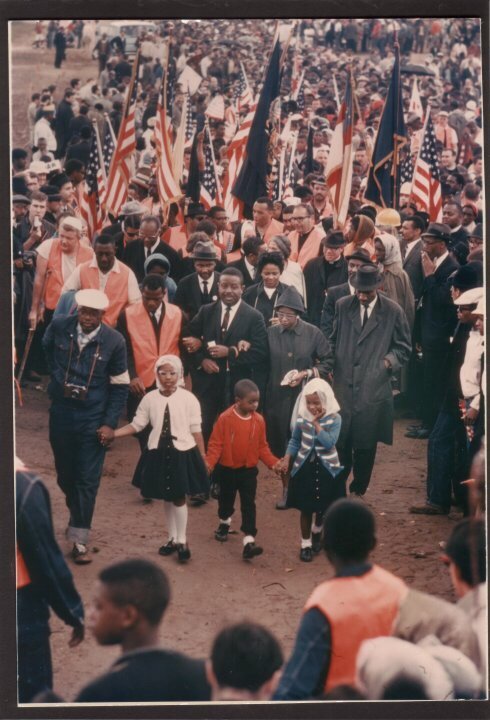From Snarling Dogs to Bloody Sunday: Teaching Past the Platitudes of the Civil Rights Movement
Teaching Reflection by Katie Lyman
Grade Level: Elementary
“I’m not teaching about civil rights this year,” my colleague asserted.
“Not teaching about civil rights?” I responded. My teaching buddy and partner had teamed with me in tackling “controversial issues” at the second/third-grade level — AIDS, the “discovery” of America, and homophobia, to name a few. I couldn’t believe that she was not going to join me in planning the civil rights unit.
The Abernathy children, Ralph David Abernathy, Juanita Jones Abernathy, and John Lewis lead the line up and beginning of the fifth day of the Selma to Montgomery March as they leave St. Jude's for the Alabama State Capitol. Photo courtesy Donzaleigh Abernathy on behalf of the Ralph David Abernathy Family
My partner explained that a parent of a child who was continuing in her second/third-grade combination class had objected to the unit on civil rights the previous year. “There was too much violence,” she had said. Her daughter had been frightened.
Knowing that I would miss our joint planning sessions and sharing of materials and ideas, I nevertheless decided to go ahead with the unit.
My own experience growing up in an exclusively white and economically privileged suburb of Milwaukee had isolated me from the issues of the Civil Rights Movement. When, as a high school student in the 1960s, I finally became informed in a U.S. history class about the events in the South and the segregation and discrimination in my own city, I was appalled. I started on the long road to try to better understand issues of racism and to do what I could to act on the inequities in our society.
Unlike the suburb I grew up in, my school attendance area is culturally, politically, and socially diverse. Over 50 percent of the students come from families of color, most of them low-income. There are also low-income and working-class white families, and a smattering of middle-class families from a new development.
I had previously received a generally positive response to the civil rights unit. Parents had shared resources, such as a battered but prized painting of Rosa Parks. One grandmother came in to teach us freedom songs and talk about her efforts in the 1960s to organize an NAACP chapter in Oklahoma.
My former principal and a few teachers had disapproved of teaching such deep and heavy issues to young children. However, I could recall only one negative comment from a parent: “Why are you still teaching Black History when it’s past February?” In fact, even though I generally started the unit on or around the observance of Martin Luther King’s birthday, related activities integrated into all subject areas extended past January and February and, depending on student interest and the depth of the projects, into the first few weeks of March.
I planned the civil rights unit within the context of a discussion of human rights and children’s rights, in honor of the upcoming 50th anniversary of the United Nations Universal Declaration of Human Rights, signed on December 11, 1949. It was during that discussion that my students had agreed that among basic rights for children is the right “to not be judged by the color of our skin.” This idea was a logical lead-in to the Civil Rights Movement.

